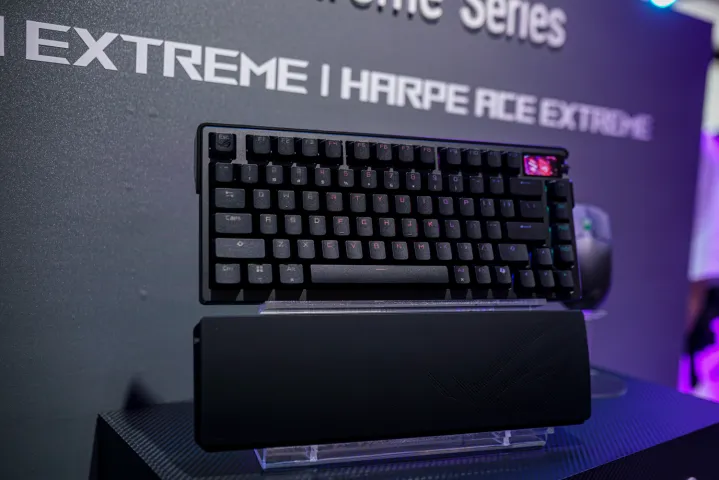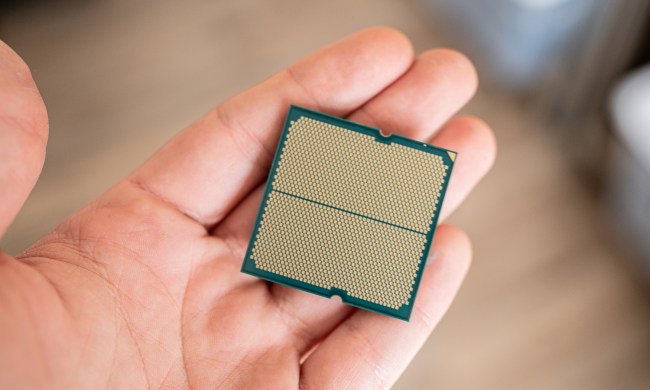
This year, Computex was absolutely packed with announcements. Even early reveals like the Asus ROG Ally X seem downright puny compared to the wave of new products companies like AMD and Intel showed off at the event.
We spent more than a week on the ground in Taipei for Computex, running to various hotels and scouring the show floor to find the biggest, most exciting new products coming out this year. Here are the seven announcements you need to know about.
Best desktop component: AMD Ryzen 9000

We expected AMD to reveal its Zen 5 CPUs at Computex, but we weren’t prepared to learn about both desktop Ryzen 9000 processors and mobile Ryzen AI 300 processors. Even more unexpected, AMD announced that both ranges would arrive in July, making Team Red the first on the scene in the next generation of both laptop and desktop CPUs.
The density of new AMD chips is unprecedented. We normally see AMD launch its desktop CPUs before laptops, and they generally arrive several months after they’re announced. The fact that we’re seeing the full Zen 5 lineup across desktop and mobile, and in just a month, is a big deal. AMD is making some big claims, too, boasting upward of a 55% increase in performance over the Intel Core i9-14900K.
For AMD, the Ryzen AI 300 chips are the star of the show, though. These are designed for Microsoft’s Copilot+ PCs, and they come with the fastest Neural Processing Unit (NPU) we’ve seen so far. AMD says its NPU is capable of 50 Tera Operations Per Second (NPU), which is even faster than the Snapdragon X Elite.
As with any new hardware launch, we have to wait until AMD’s new chips are here before seeing if the performance claims hold up. Without a doubt, though, AMD stole the show. Not only do we know about the full Zen 5 lineup but we also know that they’re arriving in a matter of weeks.
Best laptop component: Intel Lunar Lake

Intel has a new generation as well. Its Lunar Lake CPUs are arriving later this year — Intel says between July and September — and they’re made exclusively for laptops. Its next-gen Arrow Lake desktop CPUs are coming later in the year, as well. Although Intel doesn’t have as big of a density as AMD, Lunar Lake is certainly impressive.
Lunar Lake is a complete departure for Intel. The company describes it as a “radical low-power architecture,” and it’s more than a surface-level claim. Intel is outsourcing manufacturing to chipmaker TSMC for the first time ever, as well as putting a new focus on its efficient (E) cores. These cores, codenamed Skymont, are said to be the main performance driver in Lunar Lake, while the performance (P) cores, codenamed Lion Cove, step in for more demanding workloads.
Like AMD, Intel is trying to capitalize on the Copilot+ craze. It says Lunar Lake can reach up to 120 TOPS across the entire chip, with 45 TOPS coming from the NPU, and 67 coming from the redesigned GPU (the CPU has a few TOPS, as well). That redesigned GPU is a big deal, too. It’s using a next-gen architecture, codenamed Battlemage, that Intel says is upward of 50% faster than its previous generation.
Even without any concrete performance testing, Lunar Lake is a turning point for Intel. It’s the first true system-on-a-chip (SoC) from the company, the first time it’s outsourcing to TSMC, and the first time it’s focusing on efficiency over raw power. It was one of the highlights of Computex. Now, we just need to wait until Lunar Lake is actually here.
Best peripheral: Asus ROG Azoth Extreme

Onward from chips, we have the Asus ROG Azoth Extreme. The original ROG Azoth is undoubtedly one of the most impressive gaming keyboards we’ve seen, and at Computex, Asus announced an updated version. It takes the excellent foundation of the Azoth and expands it. It’s a 75% keyboard with a gasket mount, and it comes with an OLED display that can display various metrics. It also supports wireless, which is something keyboards like the Meletrix BOOG75 lack.
Almost everything is different, though. The OLED display is now full color, for example, and it’s a touchscreen. Asus also redesigned the internals, taking advantage of more board foam and a carbon fiber switch plate for an improved sound and typing feel. On the wireless front, Asus is including a new adapter that enables an 8,000Hz polling rate, as well. It’s rare enough to find wireless on a quality mechanical keyboard, much less with such a competitive polling rate.
The star of the show for the Azoth Extreme, however, is the adjustable gasket. A toggle under the Azoth Extreme allows you to adjust the gasket so it’s tighter or looser, completely changing the typing feel. This is something you can do if you build your own keyboard, but it’s usually too much of a hassle. With the Azoth Extreme, Asus is not only including the enthusiast-level feature but it’s also making the feature more accessible.
Best monitor: Acer Predator X27U F3

One of the most surprising reveals of Computex was the Acer Predator X27U F3. Acer revealed three new OLED monitors at the event, but the X27U F3 stands out with its insane refresh rate. It’s a 1440p OLED display that has a staggering 480Hz refresh rate, and this is only the second time we’ve seen a monitor sporting such specs. It was the most impressive monitor we saw at Computex this year.
Asus revealed a similar display earlier this year, but Acer might be on the market first. The company says it plans to launch the monitor between July and September, while Asus has yet to confirm a release window on its 480Hz OLED monitor. Although it’s arriving soon, the X27U F3 doesn’t come cheap. Acer says it plans to charge $1,600 for the display.
Even with such a high price, there’s no doubt that the Predator X27U F3 is an insane monitor. It’s the fastest OLED display we’ve seen so far, and it comes in with a resolution above 1080p.
Best PC building announcement: Nvidia SFF guidelines

Although it’s not tech, Nvidia’s new guidelines for small form factor (SFF) PCs were one of the more useful announcements at Computex this year. Building an SFF PC is notoriously difficult, with various layers of compatibility that you have to double-check before you order components. Even after careful planning, you can still get caught in an awkward situation if two components in your build don’t fit together properly — RAM clearance comes to mind — even if everything technically fits in the case.
Nvidia is at least making the process a bit easier with its SFF guidelines. The company is now maintaining a list of GPUs, from an RTX 4070 and up, and cases that work with each other, all of which are smaller than a traditional midtower PC. At this point, Nvidia has certified up to an RTX 4080 Super that can fit in a case as small as the 10.4-liter Fractal Terra. There aren’t any levels of compatibility here, either — any GPU on the list can fit in any case on the list.
This isn’t a new standard — Nvidia says it won’t be putting a badge of compatible products — but it’s still a helpful resource for those building an SFF PC.
Best case: Lian Li A3-mATX

Lian Li actually announced the A3-mATX about a month ago, but Computex was our first opportunity to see the case in the flesh. The tiny chassis looks wonderful, but what really stands out is the case’s insane compatibility and bargain bin price. Despite being an SFF case, Lian Li is asking just $70 for the chassis, easily making it the best case at Computex.
That’s unheard of for an SFF case, but Lian Li still didn’t skimp. As the name implies, this case is designed around an mATX motherboard, but it can also fit a mini ITX board. In addition, Lian Li supports both SFX and ATX power supplies, up to a 360mm all-in-one liquid cooler, and GPUs as long as 415mm. You can fit the highest-end hardware in this case, and it should stay cool given that Lian Li covers all corners in steel mesh.
This type of highly-compatible, modular design isn’t anything new for Lian Li, but it’s shocking to see it come in at such a low price. Cases that fit in the mATX bracket have fallen out of favor over the last few years to smaller, more expensive mini ITX designs, but the A3-mATX is a return to form. And thankfully, it’s a return that a lot of PC gamers can actually afford.
Best laptop: Asus Tuf Gaming A14

It’s no secret that the Asus ROG Zephyrus G14 is one of the best gaming laptops you can buy, but it’s expensive. In fact, most 14-inch gaming laptops, including designs like the Razer Blade 14, are expensive. Asus is taking a different approach with the Tuf Gaming A14. It’s a 14-inch gaming laptop that’s built around being portable, but it comes in at a much lower price, helping it stand out in a sea of excellent laptops at Computex.
The laptop starts at $1,400, which is several hundred dollars cheaper than you normally see for this form factor. Despite the low price, Asus says the laptop weighs just 3.2 pounds and measures just 0.66 inches thick. Even among premium 14-inch gaming laptops, those are some impressive dimensions. Asus is also packing in a 2.5K display with a 165Hz refresh rate, as well as USB-C power delivery, both of which are normally reserved for premium options.
For specs, Asus is limiting the laptop to up to an RTX 4060, which is definitely the sweet spot for this type of design. You also have the choice between one of AMD’s last-gen Ryzen 8040 CPUs or an upcoming Ryzen AI processor. Asus says it can handle the flagship Ryzen 9 AI HX 390, in fact.
Although the Tuf Gaming A14 isn’t exactly cheap, it’s still much less than other 14-inch gaming laptops. For designs like the ROG Zephyrus G14, you often have to spend over $2,000 to even get your foot in the door. The Tuf Gaming A14 is a promising sign that the tide is turning for this form factor, and Asus is the first on the scene with a highly-portable, budget gaming laptop.





